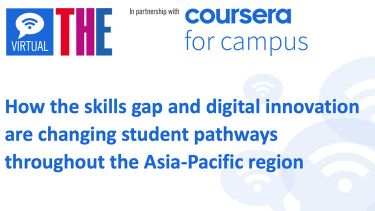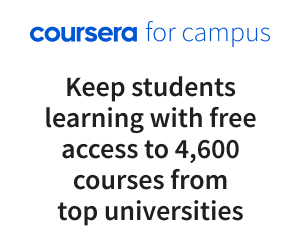While online learning has raised challenge for many students in the Philippines, it has opened many new approaches to collaboration
Round table held in December 2021.
Even before the pandemic, graduates in the Philippines faced an uncertain future as many jobs were exposed to the possibility of automation. Now the “double risk” of post-pandemic unemployment and artificial intelligence threatens some 7.2 million jobs, according to Eklavya Bhave, senior regional director for Asia Pacific and Japan at Coursera.
Discussing the importance of internationalisation at a Times Higher Education round table, held in partnership with Coursera, Bhave reflected on how digital learning can open universities to international cohorts of students and create the opportunity for home students to access academics from across the globe.
“The top five jobs, according to the World Economic Foundation, will require digital skills. So, we need to equip students to adapt to the changing world,” Bhave said. “Then we have the importance of skills such as leadership and management, as well as qualifications specific to leading companies such as Salesforce and Google.” Platforms such as Coursera for Campus can help fill gaps where universities do not have faculty coverage.
A major issue for institutions in the Philippines is the reliability of internet connectivity. Only around 40 per cent of households in the archipelago have access to broadband internet, but most have access to a mobile network.
“We have a number of students who live in isolated locations where connectivity and speed can be a challenge,” said Narciso Cellan, president of the University of San Carlos. “But this is not something they can address by themselves. We need the support of the government and other agencies.” The university has provided subsidies to faculty to cover internet costs and other incentives.
Maria Elena Paulma, vice-president for academic affairs at the University of Science and Technology of Southern Philippines, faced a similar situation. “We produced printed modules for some students in far-flung areas where there was no signal at all,” she said.
As institutions slowly reintroduce face-to-face learning, they are taking stock of how remote learning created opportunities for new connections at home and abroad. “We can explore more collaborations with partner institutions and conduct classes together online,” said Cheryl Peralta, vice-rector for academic affairs at the University of Santo Tomas. “We can do common projects and research presentations.” While these opportunities were there prior to the pandemic, the enforced switch to online learning has accelerated digital partnerships with foreign institutions, Peralta added.
Bhave explained how universities could take a hybrid approach, with core degree subjects taught face-to-face by faculty members and additional modules provided by Coursera, such as an electronic systems design course from Georgia Tech as part of an engineering degree.
Trixie Marie Sison, academic dean at Miriam College, felt the pandemic had “opened a lot of doors” for international students taking courses in the Philippines. Now that the country is seeing a return to limited face-to-face learning some students can continue to engage online while classmates can engage in person.
However, Conrado Navalta, vice-president for quality management and strategic initiatives at the Technological Institute of the Philippines, said many of his students were looking to regain the experience of being on campus. “Many complained that they missed their peers and interactions. Young people realise there is more to learning than classrooms and lectures,” he said.
Imee Martinez, director of the Office of International Linkages and assistant vice-president for academic affairs and internationalisation at University of the Philippines, concluded that success will lie in striking the right balance. “Blended learning will keep going after the pandemic, taking advantage of the positives that come from both types of modalities,” Martinez said.
The panel:
- Eklavya Bhave, senior regional director for Asia Pacific and Japan, Coursera
- Narciso Cellan, president, University of San Carlos
- Alistair Lawrence, special projects editor, Times Higher Education (chair)
- Imee Martinez, director of the Office of International Linkages and assistant vice-president for academic affairs and internationalisation, University of the Philippines
- Conrado Navalta, vice-president for quality management and strategic initiatives, Technological Institute of the Philippines
- Maria Elena Paulma, vice-president for academic affairs, University of Science and Technology of Southern Philippines
- Cheryl Peralta, vice-rector for academic affairs, University of Santo Tomas
- Trixie Marie Sison, academic dean, Miriam College
Watch the round table on demand above or on the THE Connect YouTube channel.
Find out more about Coursera.










































































